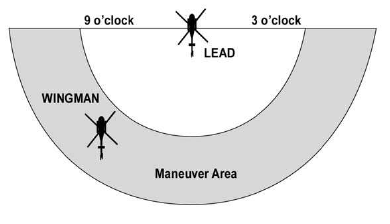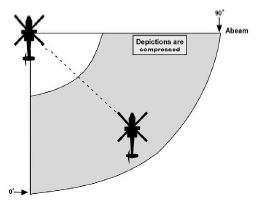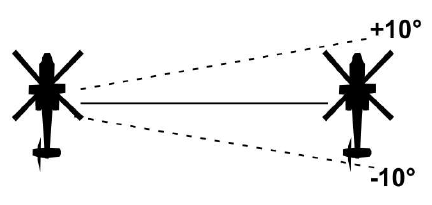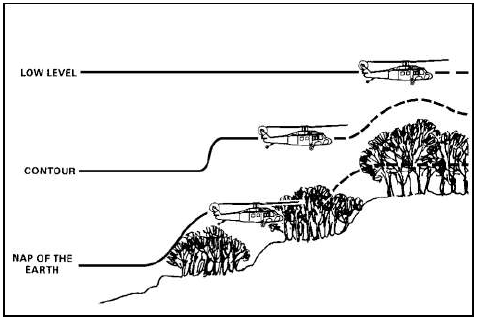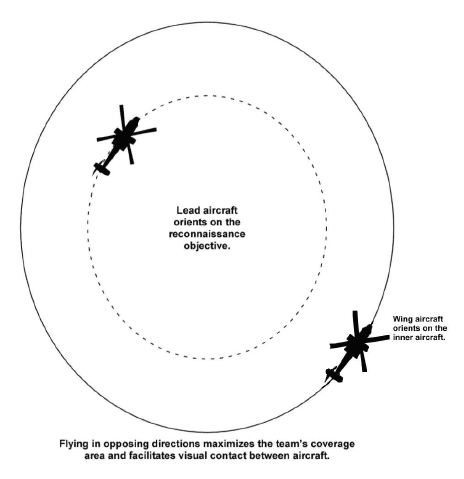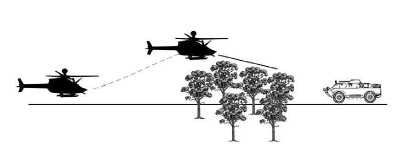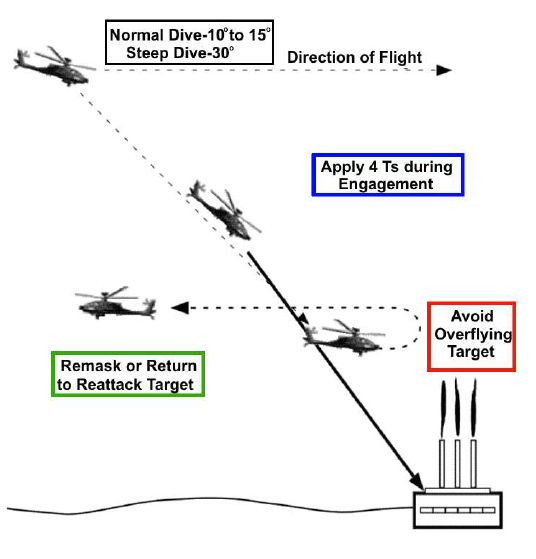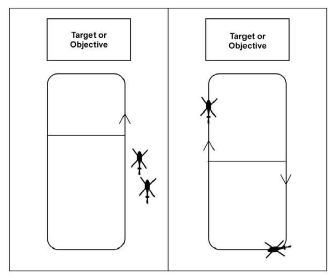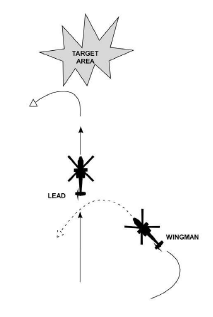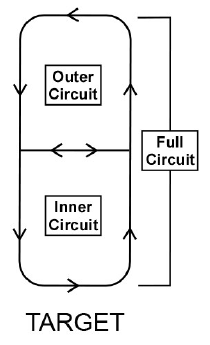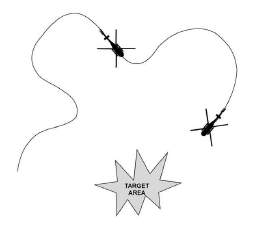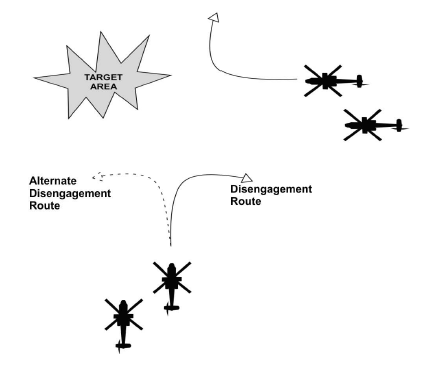Difference between revisions of "Attack Helicopter Operations"
m (→Team Manoeuvring) |
m (→Combat Cruise Right/Left) |
||
| (2 intermediate revisions by the same user not shown) | |||
| Line 48: | Line 48: | ||
*Formation spacing becomes tighter in rough terrain or reduced illumination/visibility. | *Formation spacing becomes tighter in rough terrain or reduced illumination/visibility. | ||
| − | *It is important to avoid flying over the same spot on the ground; variations in flight path between aircraft | + | *It is important to avoid flying over the same spot on the ground; variations in flight path between aircraft should be the norm. |
| − | should be the norm. | ||
*The mission dictates aircraft separation and team separation. | *The mission dictates aircraft separation and team separation. | ||
| Line 96: | Line 95: | ||
Observation sectors are divided between lead and wing providing overlapping observation and fire. | Observation sectors are divided between lead and wing providing overlapping observation and fire. | ||
| − | Combat cruise right/left | + | Combat cruise right/left formation: |
| − | + | ||
| − | permitting optimal terrain flight using masking terrain. | + | *Is preferable at very low altitudes for long flights breaking up predictability of formation and permitting optimal terrain flight using masking terrain. |
| − | + | ||
| − | threat is still high. | + | *Is preferable to combat cruise when weather and night vision systems are marginal, but threat is still high. |
| − | + | ||
| + | *Can be used at night for larger formations as an alternative to echelon when NVG are used. | ||
[[File:guns_02.png]] | [[File:guns_02.png]] | ||
Latest revision as of 23:49, 21 May 2021
Contents
Attack Helicopters
Movement
Travelling Overwatch
Company elements employ travelling overwatch when speed is essential and enemy contact is possible. This technique is normally associated with reconnaissance, security, and attack missions when threat and/or environmental conditions preclude use of bounding overwatch. Lead aircraft or teams move constantly and trail aircraft or teams move as necessary maintaining overwatch of lead.
Overwatching aircraft key their movement to terrain and their distance from the main element. It also remains ready to fire or manoeuvre, or both, providing support to main elements. Units often employ contour or NOE flight with the travelling overwatch technique using high and varying airspeeds depending on weather, ambient light, and threat.
Bounding Overwatch
Company elements employ bounding overwatch when they expect enemy contact and the greatest degree of concealment is required.
It is the slowest movement technique; too slow for high tempo operations and vulnerable for non-linear and/or urban operations. Individual aircraft or aircraft teams employ alternate or successive bounds.
One element remains in position to observe, fire, or manoeuvre before the other element moves.
Overwatching elements cover the progress of bounding elements from a covered and concealed position, which offers observation and fields of fire against potential enemy positions.
The length of the bound depends on terrain, visibility, and effective range of the overwatching weapon system.
Units normally employ contour and NOE flight with bounding overwatch technique. Airspeed during each bound is varied depending on availability of vegetation and terrain for concealment.
Team Manoeuvring
Manoeuvrability is a prime consideration for Gunship operations.
The following formations allow lead to maintain formation integrity, yet manoeuvre with few restrictions.
- Wingmen must maintain a position that will not hamper lead’s ability to manoeuvre while
providing their own horizontal and vertical clearance.
- Variations in altitude may be advantageous based on METT-TC.
- The high-low concept in conjunction with the movement technique may provide more flexibility to the team, especially in the urban environment.
- Wing may increase his altitude commensurate with the threat to utilise the potential energy of altitude to build airspeed during a diving attack.
- This provides a more stable gun platform and greater manoeuvrability for egress off the target.
- Over open terrain or during high illumination, greater spacing is used to increase survivability and flexibility.
- Formation spacing becomes tighter in rough terrain or reduced illumination/visibility.
- It is important to avoid flying over the same spot on the ground; variations in flight path between aircraft should be the norm.
- The mission dictates aircraft separation and team separation.
- Aircraft and team separation may range from 3-5 rotor disks to 1 kilometre or more.
- Primary concern when establishing separation is METT-TC and the ability to provide mutual support.
The basic Gunship formations are:
- combat cruise,
- combat cruise left and right, &
- combat spread.
Combat Cruise (sometimes referred to as ‘Free Cruise’)
Combat cruise is used when teams wish to move quickly and maximize use of terrain for masking.
Combat cruise allows the wingman flexibility in manoeuvring the aircraft left or right of the lead aircraft’s centreline.
The wingman should never track in straight trail as it limits forward observation and the ability to provide suppressive fires for lead.
It also increases the possibility that the lead’s presence has alerted the enemy to the wingman’s flight path.
Separation should be 150 meters or more depending on terrain and threat.
Combat cruise formation is—
- Preferable at very low altitudes for long flights breaking up the predictability of the formation and permitting optimal terrain flight using masking terrain.
- Preferable during day and high visibility weather when small arms fire threat is substantial.
Combat Cruise Right/Left
Unlike combat cruise, combat cruise right/left requires the wingman remain in either right or left cruise and change sides only after coordinating with the lead aircraft.
Using combat cruise right/left, the wingman remains in an arc 0 to 90 degrees aft abeam of lead to the left or right side.
Optimum position is 45 degrees. Separation should be 150 meters or more depending on terrain and threat.
Observation sectors are divided between lead and wing providing overlapping observation and fire.
Combat cruise right/left formation:
- Is preferable at very low altitudes for long flights breaking up predictability of formation and permitting optimal terrain flight using masking terrain.
- Is preferable to combat cruise when weather and night vision systems are marginal, but threat is still high.
- Can be used at night for larger formations as an alternative to echelon when NVG are used.
Combat Cruise WIDE
In DCS during daylight it is frequently difficult or impossible to see from within the cockpit AAA gun or cannon fire directed at you until the aircraft is terminally damaged.
At best you may be aware of tracer flying past the cockpit but unless the attacker is clearly near and visually obvious, its location will not be seen.
However, this tracer fire is often seen by an element located at least 100m or more off to one side, the further away the better the degree of visibility.
In order to improve survivability in areas known or suspected to have AAA capability, WING will adopt Combat Cruise WIDE, left or right dependent on anticipated break or egress direction.
This position should be slightly higher than, and as far to one side of LEAD as possible, whilst still maintaining visual contact - ideally at the 4 or 8 o’clock position.
This will best facilitate either LEAD or WING recognising incoming tracer AAA, calling break to the targeted element and noting the tracer source position.
Normally both LEAD & WING will break, re-form and plan an attack if appropriate.
Combat Spread
Combat spread promotes security by providing maximum fire-power forward and overlapping fields of view (FOVs).
When flight lead announces combat spread, he includes the command left or right.
Wingmen should move toward that abeam position, either lead’s 3 or 9 o’clock position.
Flying in combat spread requires a rapid scan to maintain situational awareness of the other aircraft as well as approaching terrain; this requires even more vigilance at night.
For planning, the wingman should maintain approximately ten rotor disk separation from the lead aircraft.
Team leaders may vary the maximum lateral separation between aircraft based on visibility, manoeuvre space available, and expected enemy weapon ranges.
Combat spread formations:-
- Can be used when maximum observation to the front is desirable or when attempting to limit exposure of the flight when crossing open areas.
- May be used en route to minimise vulnerability of trail aircraft.
- Are not advised for use in the objective area when constant manoeuvring is required.
- Increase pilot workload to maintain formation, especially under night vision systems.
Modes of Terrain Flight
Terrain flying includes appropriate tactical application of low-level, contour, and NOE flight techniques as appropriate, diminishing the enemy’s capability to acquire, track, and engage aircraft.
Terrain flight requires aircrew proficiency in map reading, preparation, and terrain interpretation and requires constant vigilance in identifying terrain features and hazards.
Continuous NOE or contour flight is unusual because terrain and vegetation vary. Normally, there is a transition from one mode to the other as the situation dictates. Modes of terrain flight are defined below.
Nap-of-the-earth flight
NOE flight is conducted at varying airspeeds as close to the earth’s surface as vegetation and obstacles permit. Aviators should decrease airspeed if weather and ambient light restrict visibility.
- Altitude and airspeed will vary according to the factors of METT-TCS. Enemy contact IS expected.
- Altitude should not exceed 25 feet above highest object (AHO)
- Airspeed should not exceed 40KIAS
Contour flight
Contour flight is conducted at low altitude conforming to the earth’s contours.
It is characterized by varying airspeeds and altitude, dictated by the terrain and obstacles.
Aviators should decrease airspeed if weather and ambient light restrict visibility.
- Used for Travelling or Travelling overwatch techniques of movement.
- Enemy contact is possible
- Low altitude conforming to the surface of the earth
- Airspeed not to exceed VNE
Low-level flight
Aviators perform low-level flight at constant altitude and airspeed, dictated by threat avoidance.
Aviators should decrease airspeed if weather and ambient light restrict visibility.
- Constant airspeed and indicated altitude
- Travelling technique of movement
- Enemy contact is NOT likely
- Minimum altitude 50 feet AHO
- Airspeed not to exceed VNE
Masking & Unmasking
Masking is a technique utilising terrain to mask (cover or conceal) the aircraft from threat detection and weapons employment.
Unmasking is a manoeuvre used when it becomes necessary to observe points of interest that are obscured while in a masked position.
Before unmasking, a thorough map reconnaissance should be completed so that all eyes can be focused outside during the unmasking.
The three general types of unmasking are as follows:
Unmasking in flight
This type is used when the aircraft has forward speed and can best be described as a quick "pop up and peek" at the desired point or area of observation.
It is usually used while flying behind a ridge-line or other linear barrier.
Unmasking at a hover (vertically)
Moving the aircraft vertically from a hover position behind a feature.
When possible, unmask at a safe distance from the mask to allow a rapid descent to a masked condition if the aircraft is detected or fired upon.
Be aware of a common tendency to move forward or rearward while vertically unmasking and re-masking.
Establish reference points to assist in maintaining position during ascents and descents and keep aircraft exposure time to a minimum.
Unmasking at a hover (laterally)
Sometimes, the aircraft may be unmasked by moving laterally from the feature to provide the smallest silhouette possible to enemy observation or fire. Keep aircraft exposure time to a minimum.
Avoid mid-air collision
Once all significant air threats are eliminated, an orbital pattern can be undertaken to observe
When flying as a pair, maintaining seperation can be achieved by the following:
- flying in opposite directions,
- flying at different altitudes,
- flying in different radii orbits.
Attack Methods
Gunships may employ different attack methods to engage the enemy and these are generally classed as:
High attack
High attack is used during diving fire when aircraft are required to maintain higher altitudes, normally greater than 1,000 feet. Useful for following targets through urban areas.
Other advantages include:
- aircraft remain above accurate small arms fire
- retaining energy for manoeuvre,
- allows for greater target identification within urban areas or restrictive terrain, &
- minimises weapon’s effects dispersion.
A disadvantage is the higher altitudes enable greater effectiveness of some threats such as missiles.
Low-level attack
Low-level attack is used when the aircraft is required to maintain near terrain or NOE when engaging
a target; normally used during hover or running fire.
An advantage of this technique is:
- the aircrew’s ability to maintain a lower profile that is masked by background terrain or vegetation making it difficult for the enemy to judge closure.
A disadvantage is the aircrew cannot engage the target at maximum range of the weapons system due to targeting hindered by a level viewing angle.
Additional disadvantages include:
- limited LOS,
- decreased accuracy (both initial and subsequent rounds)& wider dispersion resulting in decreased weapons effect &
- increased chances for fratricide and collateral damage.
Bump or pop-up attack
The bump or pop-up attack is used to take advantage of masking terrain while increasing the angle
of attack; normally used during running fire, transitioning to diving fire.
Each aircrew pops up up prior to or during weapons engagement and then returns to terrain flight altitude.
Advantages of this technique are:
- the aircrew’s increased ability for longer distance engagements,
- dispersion of weapon’s effects is deceased,
- look-down angle is increased making target identification easier, &
- aircraft momentum is maintained for manoeuvre.
Disadvantages include:
- silhouetting of aircraft on horizon during bump, &
- excessive bump reduces airspeed and energy for manoeuvre.
Firing Techniques
Firing helicopter weapons systems requires a great deal of skill by the pilot. These skills require constant development and sustainment and include aircraft control and burst on target.
Diving Fire
The diagram below shows diving fire.
Team Attack Pattens
Teams utilise attack patterns to maximize weapons effectiveness and minimise exposure to the threat. Examples of attack patterns utilised by the SWT are racetrack pattern, L attack, and cloverleaf attacks.
Simultaneous Attack
A simultaneous attack is executed from combat spread or combat cruise formation and is normally utilised when taking fire from the target area. Wingman’s attack is timed to provide suppressive fire for lead’s break-off of the target.
Example of simultaneous and continuous attacks
Wingman may also fly roughly 45 degrees offset from lead on the side opposite lead’s break.
Wingman should maintain greater stand-off during attack run because lead cannot provide coverage.
Continuous Attack
- A continuous attack separates team movement with only one team member inbound to the target area at a time.
- This technique is normally employed when the threat to the team is low or constant fire is desired on the target area.
- A continuous attack requires greater control and timing; lead should maintain an established airspeed in order for wingman to maintain proper spacing.
- Once this relationship is understood, modifications of the break line, speed, and delivery techniques may be made.
Race Track Pattern
- The racetrack pattern is divided into three circuits based on weapon system capabilities and average attack speed.
- The three circuits are full, outer, and inner .
- Full circuit. : Provides maximum stand-off and is primarily used for missile engagements.
- Outer circuit. : Outside enemy crew-served weapons range and allows gun, rocket, and missile delivery; accuracy is reduced for gun and rocket engagements.
- Inner circuit. : Outside enemy small arms range and enables gun and rocket engagements with best accuracy.
Cloverleaf Attack Pattern
- The cloverleaf pattern is a basic variant to the racetrack pattern and eliminates the predictability caused by multiple attack runs from the same direction.
- When utilised with multiple teams the enemy is confronted with a high volume of fire from constantly changing directions.
L-Attack Pattern
- The L-attack pattern is used to attack a target requiring a large volume of fire for a short duration utilizing two Gunship Teams.
- This pattern is capable of attacking linear targets masked by high terrain or obstacles on one side.
- Timing between teams is critical to provide simultaneous fire against the target.
‘Figure ‘8’ Patten
- The ‘Figure 8’ patten is where 2 UH-1h gunships with door guns fly opposing sides of a figure ‘8’ patten and the door gunners maintain continuous suppressing fire at an enemy which must be positioned on one side of an LZ only.
Random Patten
Often the terrain and position of the enemy does not lend itself to a symmetrical pattern, so the GST may establish a pattern conforming to the situation.

